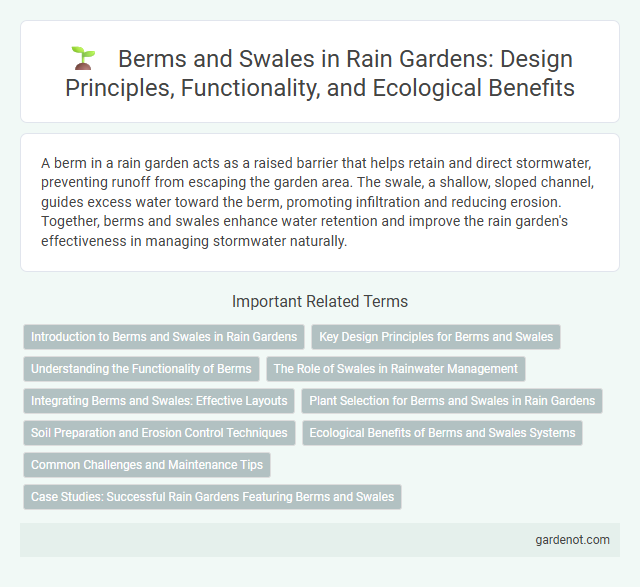A berm in a rain garden acts as a raised barrier that helps retain and direct stormwater, preventing runoff from escaping the garden area. The swale, a shallow, sloped channel, guides excess water toward the berm, promoting infiltration and reducing erosion. Together, berms and swales enhance water retention and improve the rain garden's effectiveness in managing stormwater naturally.
Introduction to Berms and Swales in Rain Gardens
Berms and swales are critical landscape features in rain gardens designed to manage stormwater runoff effectively. A berm is a raised barrier built from soil that directs water flow, while a swale is a shallow, vegetated channel that slows, filters, and absorbs rainwater. Together, berms and swales enhance infiltration, prevent erosion, and improve water quality by capturing and treating runoff before it enters storm drains or natural waterways.
Key Design Principles for Berms and Swales
Berms and swales in rain garden design require precise grading to ensure effective stormwater runoff management and infiltration. Berms should be constructed with stable, compacted soil to prevent erosion, while swales must have gentle slopes and vegetative cover to facilitate slow water flow and absorption. Proper sizing and placement based on watershed area and soil permeability are critical to maximize water retention and support native plant growth.
Understanding the Functionality of Berms
Berms in rain gardens act as raised barriers designed to control water flow and prevent runoff from escaping the garden area. By directing stormwater into the swale, berms help maximize infiltration and reduce erosion, enhancing the garden's ability to manage rainwater effectively. Properly constructed berms contribute to maintaining soil moisture and supporting native plant growth within the rain garden ecosystem.
The Role of Swales in Rainwater Management
Swales play a crucial role in rainwater management by channeling and slowing runoff to promote infiltration and reduce erosion. Unlike berms, which act as raised barriers, swales are shallow, vegetated depressions that capture and filter stormwater, enhancing groundwater recharge and improving water quality. Their design maximizes the absorption of rainwater, mitigating flood risks and supporting sustainable landscape drainage.
Integrating Berms and Swales: Effective Layouts
Berms and swales form essential components of rain garden design, enhancing water flow management and infiltration. Proper integration of berms and swales directs stormwater runoff efficiently, preventing soil erosion and promoting groundwater recharge. Strategic placement considers slope, soil type, and vegetation to maximize water retention and support native plant growth.
Plant Selection for Berms and Swales in Rain Gardens
Plant selection for berms and swales in rain gardens should prioritize native species with deep root systems to enhance soil stabilization and water infiltration. Drought-tolerant grasses and flowering perennials like Carex, Echinacea, and Rudbeckia thrive on berms, while moisture-loving plants such as Juncus, Pontederia, and Lobelia are ideal for swales to manage standing water. Choosing diverse species that support local wildlife also promotes ecological balance and resilience in rain garden microhabitats.
Soil Preparation and Erosion Control Techniques
Berms and swales in rain gardens require precise soil preparation to enhance infiltration and support native vegetation growth, often involving soil amendment with compost and the removal of compacted layers. Effective erosion control techniques include installing temporary silt fences, using mulch to stabilize soil surfaces, and planting deep-rooted grasses that anchor the soil and reduce runoff velocity. These methods collectively improve water absorption, prevent sediment displacement, and maintain the structural integrity of the rain garden landscape.
Ecological Benefits of Berms and Swales Systems
Berms and swales in rain garden systems enhance stormwater management by promoting infiltration and reducing runoff, which helps recharge groundwater and minimizes erosion. These structures provide critical habitats for native plants and wildlife, increasing biodiversity and supporting ecological balance. By filtering pollutants such as sediments, nutrients, and heavy metals, berms and swales improve water quality and contribute to healthier urban ecosystems.
Common Challenges and Maintenance Tips
Berms and swales in rain gardens often face issues such as soil erosion, water pooling, and clogging due to sediment buildup. Regular inspection and removal of debris, alongside strategic planting of native vegetation, help stabilize soil and improve water infiltration. Proper grading and periodic reshaping of berms and swales are essential to maintain optimal runoff flow and prevent overflow.
Case Studies: Successful Rain Gardens Featuring Berms and Swales
Case studies of successful rain gardens frequently showcase berms and swales as effective landscape features for stormwater management and erosion control. The Cypress Creek Rain Garden in Texas utilized berms to redirect runoff, while the Madison Community Rain Garden incorporated swales to enhance infiltration and pollutant removal. Both examples demonstrate how strategic berm and swale integration improves rain garden performance by optimizing water flow and retention.
Berm and swale Infographic

 gardenot.com
gardenot.com